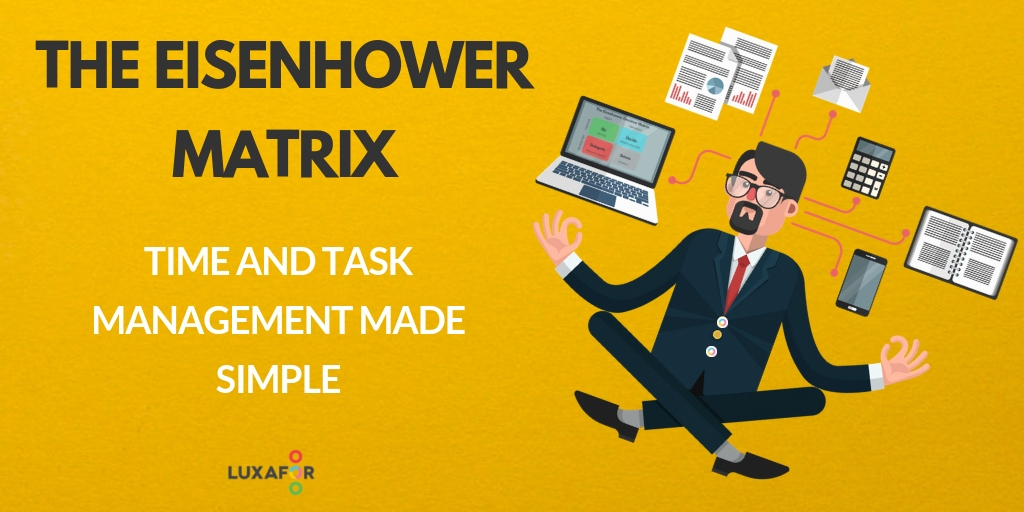The Eisenhower Matrix: Time and Task Management Made Simple
- Updated on: July 27, 2024
The Eisenhower Matrix, also known as the Urgent-Important Matrix, is a task management system that helps prioritize tasks based on their urgency and importance. It divides tasks into four quadrants: Urgent and Important, Important but Not Urgent, Urgent but Not Important, and Not Urgent and Not Important.
The Eisenhower Matrix is the best answer to time and task management issues caused by bad prioritizing. The Eisenhower Matrix is a time management tool that helps you prioritize tasks based on their urgency and importance.
The inventor of the principle
The Eisenhower Matrix is named after Dwight David Eisenhower – an American army general and statesman who served as the 34th President of the United States from 1953 to 1961. During World War II, he was a five-star general in the United States Army and served as Supreme Commander who prepared the strategy for an Allied invasion of Europe.
Dwight D. Eisenhower famously said, “I have two kinds of problems, the urgent and the important. The urgent are not important, and the important are never urgent.”
Dwight made tough decisions continuously about which of the many tasks he should focus on each day. This finally led him to invent the world-famous Eisenhower Method, which today helps us prioritize by urgency and importance.
Through the Eisenhower principles of planning, prioritizing, delegating, and scheduling you will start to see the right things to do in order to achieve your goals and be more productive by developing highly effective habits for yourself.

How to use the Eisenhower Matrix
The Eisenhower Matrix (sometimes called the Eisenhower Box or Eisenhower Decision Matrix) is an easy, yet extremely effective way to prioritize and manage tasks and your time according to priorities and urgent tasks.
It is a system that basically makes you separate all your activities into four priority levels, one of which (Not Important/Not Urgent) is immediately dropped. So really it’s only three categories of attention-worthy tasks to focus on (see the picture below).
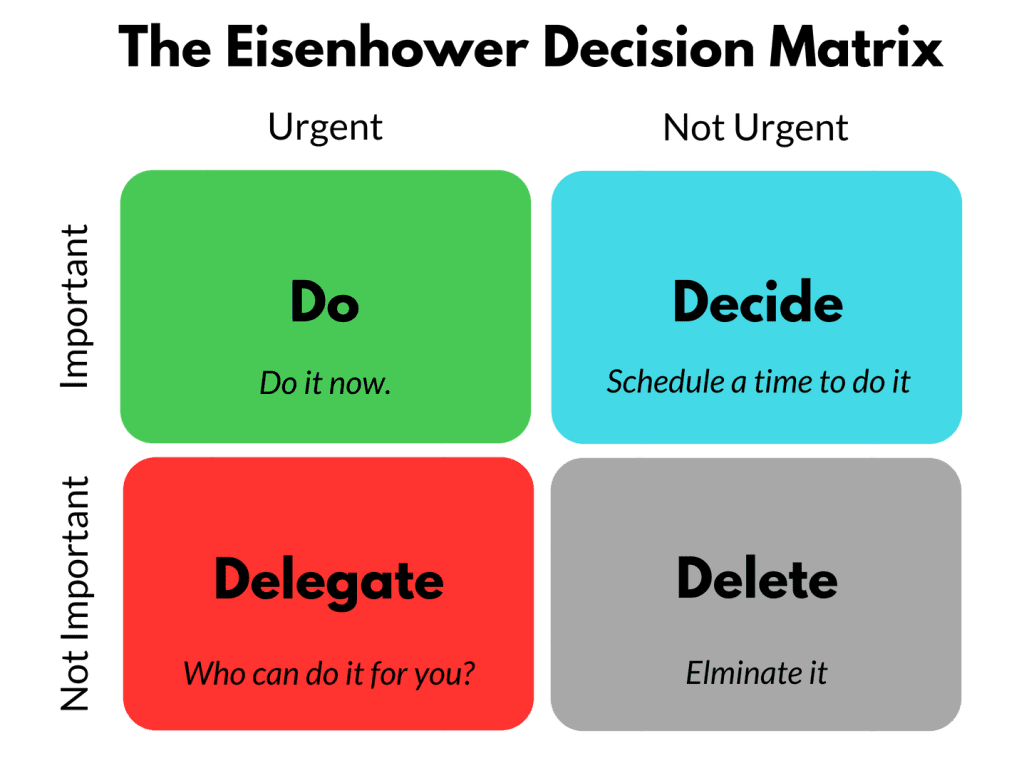
- “Important” and “Urgent” tasks. These receive the highest priority level and should be your primary focus to complete as soon as possible (most often on the same day).
- “Important”, but “Not Urgent” tasks. These are the long-term goals and tasks that are important but don’t have a firm deadline yet. You should schedule them in a timely manner, doing the most urgent ones right after you’ve finished everything from the “Do” quadrant.
- “Not Important”, but “Urgent” tasks. These tasks are the ones you can delegate to other professionals or appoint to complete yourself if you must, but only after your first and second quadrant tasks are completed.
- “Not Important” and “Not Urgent” tasks. The tasks are placed in the “Delete” quadrant because you should eliminate doing them. This may vary due to the perception of urgency and importance, but mainly these tasks don’t even need to be done and would be considered a complete waste of time by most people.
The "Do" quadrant
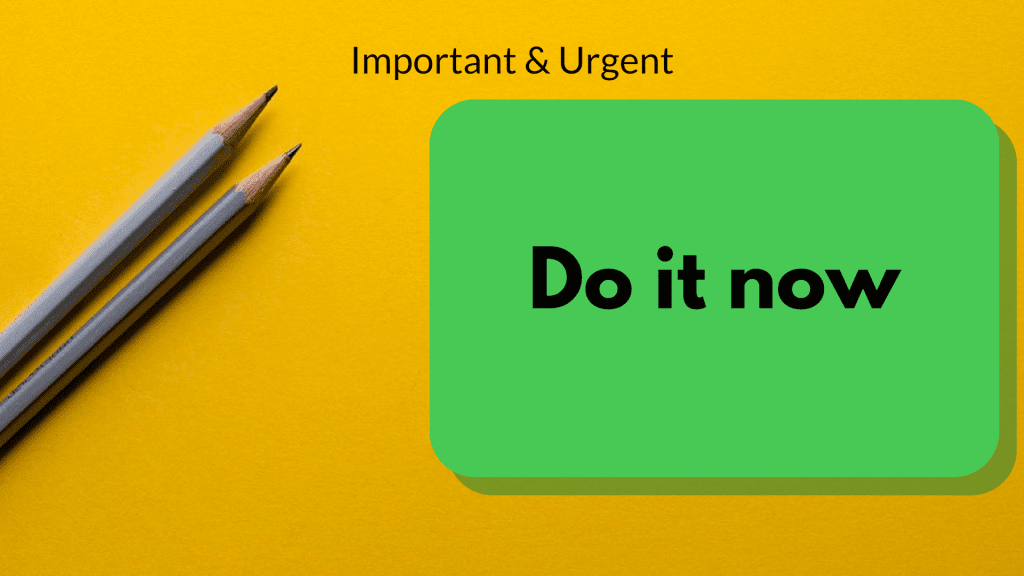
We call the first quadrant “Do” as these tasks are very important and just need to be done preferably on the same day and not later than the next day. These are the tasks that need to be done in order to avoid negative consequences. Examples of the “Do” quadrant would be crises, deadlines, and urgent problems.
These are usually the most time and energy-consuming tasks of the day. You know – the ones you really don’t want to start due to the amount of energy you’ll have to invest in them…
- You should use Mark Twain’s Eat the frog first principle for this kind of tasks. This works because you’re more likely to enjoy completing the next item on your list once you have completed the first one. Also, it is a great way to discipline yourself and gain higher self-respect when you acknowledge the completion of the hardest to-do item.
The tasks on the “Do” quadrant are important and urgent after all, so start with them and you’ll see how easy everything else will seem much easier to carry out after completing them.
- A great way to make sure you execute these tasks is to use the Pomodoro technique, which would help you focus on the task more productively. Read more about the Pomodoro technique here.
- To make wise planning a highly effective habit, you must devote one place where you will write down your “Do” tasks on a regular basis. In any planner, it is possible to dedicate space daily and monthly to pin down the tasks that are Important and Urgent and even break them down into actionable steps.
The "Decide" quadrant
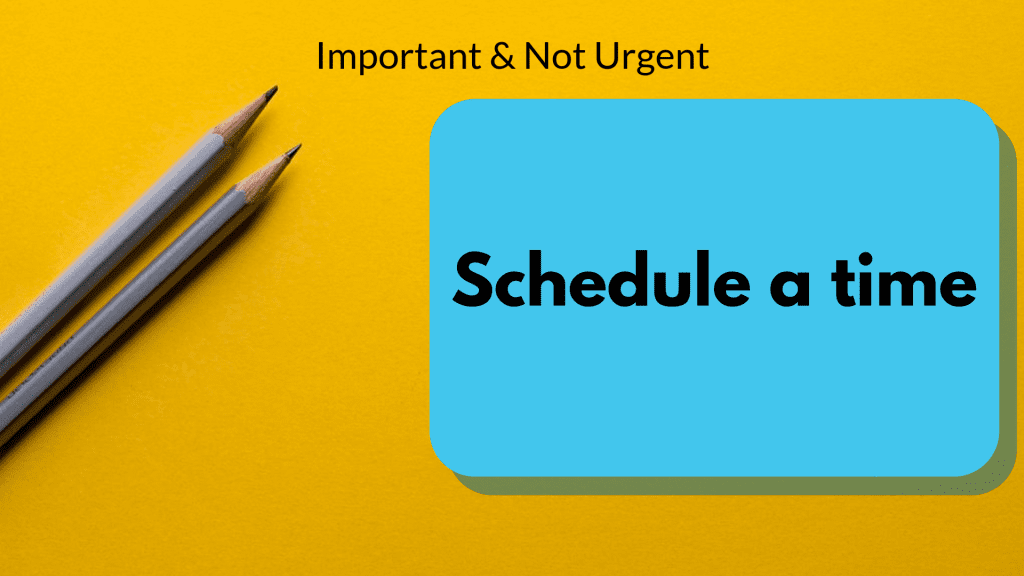
The second quadrant of The Eisenhower Matrix we call “Decide“. These tasks are important but less urgent.
Efficient time managers leave fewer things unplanned and therefore try to manage most of their work in the second quadrant. It is reducing stress by terminating urgent and important to-dos to a reasonable date in the near future whenever a new task comes in.
Remember – only because these are not considered urgent doesn’t mean you shouldn’t schedule realistic deadlines. Make sure to set yourself a fair time estimate.
- You should organize and plan tasks like this into your daily/weekly to-do lists. Try to follow the tips available in this article to make the most efficient to-do lists for this kind of tasks.
The "Delegate" quadrant
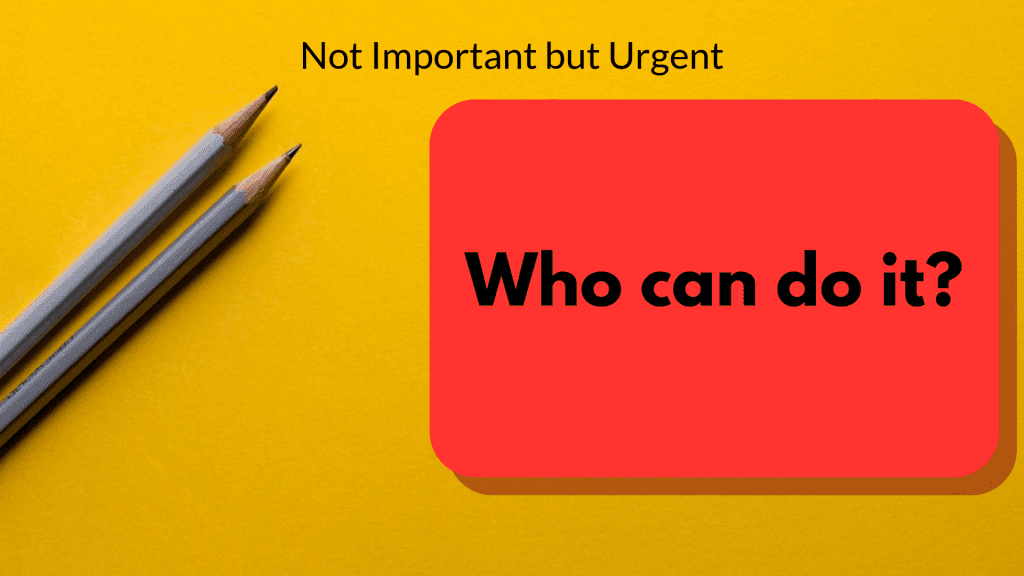
We call the third quadrant like this because the tasks are less important to you than to others but still pretty urgent. This is where having a team spirit comes crucial in any company culture.
These are tasks that technically you could do yourself, but suggesting a better person for the job means improved teamwork. And also you will have more time to complete the tasks from the first two quadrants when you consider delegating tasks that are not as urgent.
- You should keep track of delegated tasks by telephone, e-mail, or within a meeting to check on their progress later. Delegating without a tracking option is as worthless as not doing the task at all because in the end nobody could be held accountable. And no business needs tasks piling up without anyone taking care of them.
- There are many task and time management tools available nowadays that could help you with tracking progress. We’re sure you can find the one that fits your work specifically from our Ultimate productivity tool guide.
The "Delete" quadrant
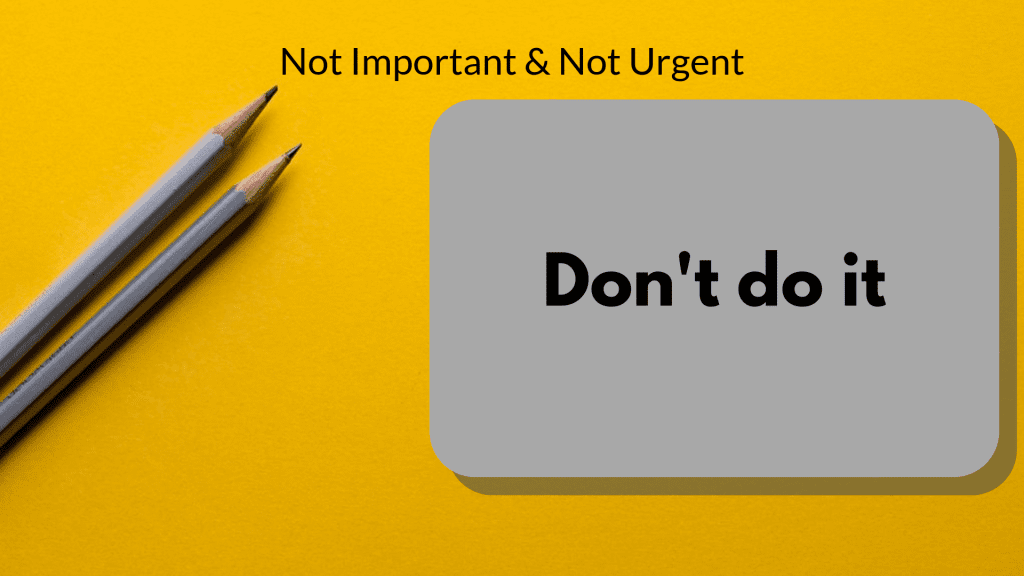
The last quadrant in the matrix is called “Delete” because it makes you consider the things you should not be doing at all and “delete” them from your daily/weekly routine.
Discover and stop the bad habits that basically are a complete waste of time and do not make you productive. These are time wasters, such as surfing the internet for no reason or wasting time on unimportant and irrelevant emails. To help you with time management:
- Use a planner to write down “Delete” tasks in the dedicated monthly area of “Not-To-Dos”.
- Set out specific times during the day when you will check emails, answer phone calls, or any other incoming correspondence (unless you work in customer service, where these tasks fall into the category of “Do”). And don’t do any of these tasks outside of the set timings.
- Use one of the social media blocking tools available in our Ultimate Productivity Tool Guide to let them do the job of restricting your access to such distractions during work hours.
Guidelines for using The Eisenhower Matrix
- Make to-do lists. This frees your mind from constant memorization. Plus, this way you’ll hold yourself accountable for the tasks you have prioritized on.
- Set a limit of tasks you can include in one quadrant. We love working with a formula of no more than 8 tasks per quadrant.
- Always question what is worth doing first. Use Mark Twain’s Eat the frog first principle for tasks from the “Do” and “Decide” quadrants. Eating the frog first will give you tremendous energy and momentum.
- Use the Pomodoro technique to make the most of your workday. Focus on one task only during one Pomodoro session.
- Plan in the evening before and review early in the morning, then work on your stuff.
- Eliminate distractions. Do not let others define your priority. Good headphones can block out ambient noise. If your co-workers are ignoring boundaries status lights as Luxafor can stop them from bothering you during your peak performance hours.
- Use tools to help you stay off the bad habits, such as social media blocking tools to stop you from browsing during working hours.
- Keep track of the tasks you delegate to others to see the progress with the help of task and time management tools.
- Finally, try not to procrastinate that much. Not even by over-managing your to-dos.
LUXAFOR HELPS PEOPLE TO ACHIEVE THEIR GREATEST PRODUCTIVITY LEVELS WITH A WIDE VARIETY OF OFFICE PRODUCTS. WITH OVER A DECADE OF EXPERIENCE IN THE PRODUCTIVITY AND TIME MANAGEMENT SPACE, WE CAN SURELY HELP YOU OUT – LET’S BE PRODUCTIVE TOGETHER!
The Eisenhower Decision Matrix Template (Downloadable PDF)
Struggling to prioritize between urgent and important tasks – look no further than the Eisenhower Matrix! You have a chance to conquer your to-do list with our FREE Eisenhower Matrix PDF. Download it now and boost your productivity in minutes.
Tips for Using the Eisenhower Matrix Template:
- Be specific: Clearly define your tasks.
- Prioritize regularly: Review and update your matrix often.
- Delegate or eliminate: Focus on quadrants I and II.
- Use a visual tool: Consider using our ready-made template – print it out or use it as a digital tool for a visual representation.
This template provides a user-friendly format to categorize your tasks visually. Here’s how to use our Eisenhower Time Management Matrix template PDF:
- Download the Template: Press on the download button of Eisenhower Matrix PDF below, fill the required fields and print it out or fill it in digitally.
- List Your Tasks: Brainstorm and list all your pending tasks within the designated sections of the template.
- Prioritize: Objectively evaluate each task based on urgency and importance. Place them in the corresponding quadrant of the matrix.
- Take Action: Develop an action plan based on the prioritized tasks. Prioritize your tasks and do the most urgent ones right away, schedule important tasks, delegate less critical ones, and eliminate what doesn’t add value.
Download the Printable Eisenhower Matrix Template PDF
How to Prioritize Tasks?
Here are some useful steps on how to best prioritize the tasks for the Eisenhower Matrix:
1. Brainstorm Your Tasks: List everything you need to do on a piece of paper or digitally.
2. Analyze Each Task: Ask yourself these questions for each task:
Is this task urgent? Does it have a strict deadline or immediate consequences if not completed? Is this task important? Does it contribute significantly to your goals?
3. Assign Each Task a Quadrant: Based on your urgency and importance analysis, place each task in the appropriate quadrant.
Eisenhower Task Matrix Examples
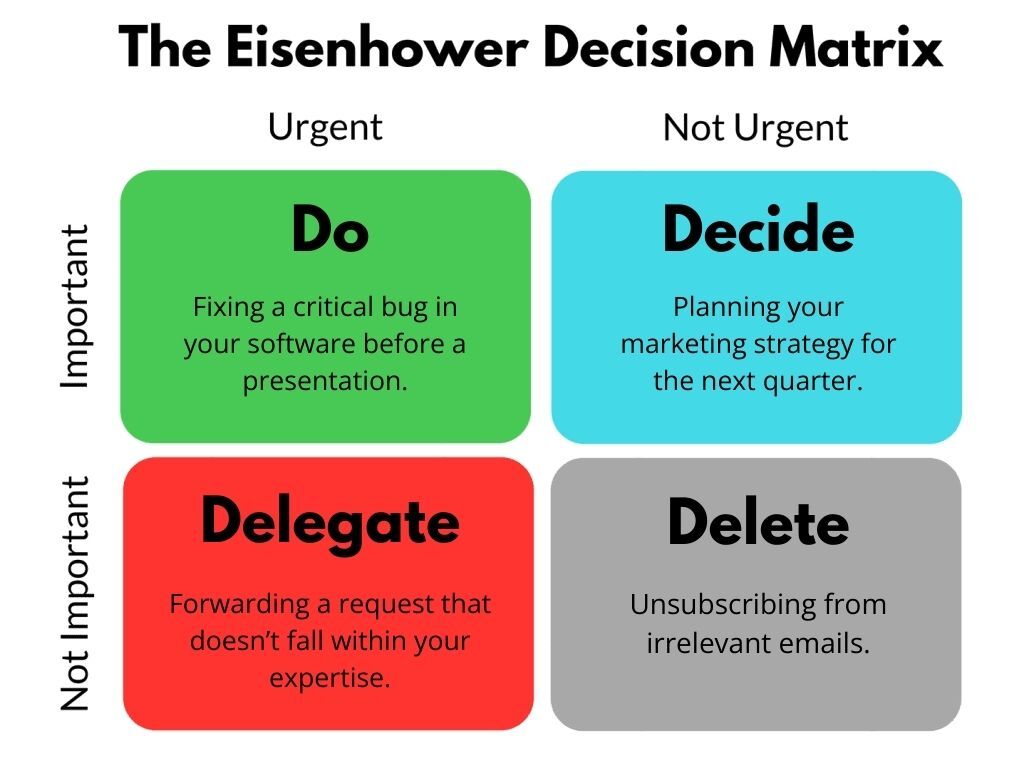
Urgent & Important (Do it now)
These tasks demand immediate attention and have significant consequences if not completed.
Example: Fixing a critical bug in your software before a presentation.
Important, Not Urgent (Schedule for later)
These tasks contribute significantly to your goals but don’t require immediate action. Scheduling them ensures they get done.
Example: Planning your marketing strategy for the next quarter.
Not Urgent, Not Important (Delegate or Eliminate)
These tasks offer minimal value and don’t require your personal attention. Consider delegating them to others or eliminating them altogether to free up your time for more important tasks.
Example: Unsubscribing from irrelevant emails. (Delegate to an assistant) or Checking personal social media during work hours. (Eliminate)
Urgent, Not Important (Decide or Delegate)
These tasks often feel urgent due to external pressures but don’t contribute much to your goals. Consider delegating them or tackling them only after completing important tasks.
Example: Responding to a friend’s non-urgent text message while working on a deadline. (Decide) or Forwarding a colleague’s request that doesn’t fall within your expertise. (Delegate)
Remember: Don’t be afraid to delegate or eliminate tasks that don’t contribute much to your goals. By focusing on the “Do it now” and “Delegate” quadrants, you’ll achieve more with less stress.
Download the Printable Eisenhower Matrix Template PDF
FAQ About Using The Eisenhower Decision Matrix
What is the Objective of Eisenhower Matrix?
The main objective of the Matrix is to increase your productivity by focusing on the most important and impactful tasks, doing so you can increase productivity and get more done. The Eisenhower matrix will help you to understand your goals better, Identify time-wasting activities, and most importantly to learn how to prioritize your work and everyday tasks. The Eisenhower Matrix helps to identify your utmost important tasks and focus on completing them as priority.
What are the differences between the Eisenhower matrix vs Covey matrix?
The Eisenhower Matrix and Covey Matrix are both time management tools designed to prioritize tasks, but they have distinct differences.
The Eisenhower Matrix categorizes tasks into four quadrants based on urgency and importance. The Covey Matrix also uses a four-quadrant system but emphasizes the time aspect of the tasks, focusing more on the time each task takes to complete.
Also, the Eisenhower Matrix labels the quadrants either do, decide, delegate, or delete, based on their urgency and importance, while the Covet matrix does not.
Can the Eisenhower Matrix be used for team projects?
Yes, the Eisenhower Matrix can be applied to team projects to help prioritize collective tasks, improve workflow, and ensure that the team focuses on high-priority activities.
Can the Eisenhower Matrix help with long-term goal planning?
Yes, the Eisenhower Matrix can assist with long-term goal planning.
Specifically, the important but not urgent task quadrant (Quadrant II) addresses the longer-term tasks and goals, ensuring that they get completed and are not forgotten by setting a specific time for their completion.
This approach prevents these tasks from becoming urgent crises in the future and helps maintain a steady progress towards long-term goals.
How often should you review and update your Eisenhower Matrix?
You should review and update your Eisenhower Matrix daily and weekly. Here's a practical guide to doing this:
Daily Review: At the beginning or end of each day, spend a few minutes reviewing your tasks. Update the matrix based on new tasks, shifting priorities, or completed items.
Weekly Review: Dedicate time at the start or end of each week to a more comprehensive review. Evaluate your progress on long-term goals and adjust tasks in the Important but Not Urgent quadrant.

